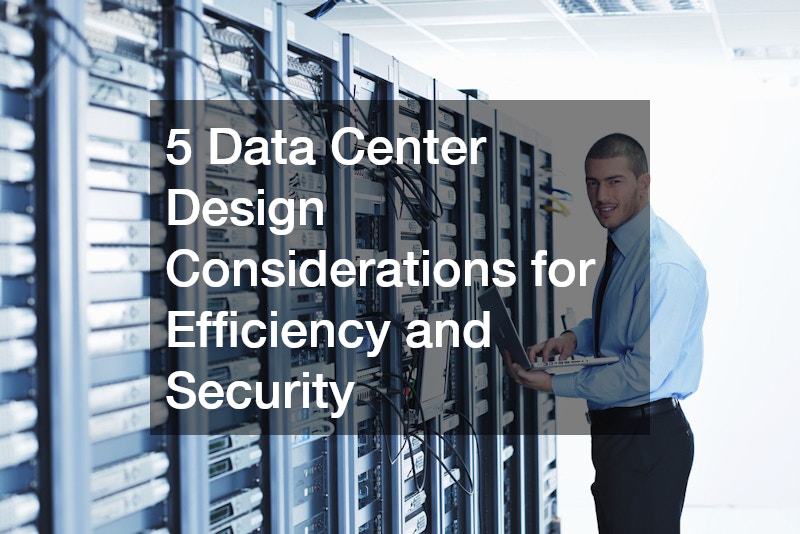Designing a data center is no small feat. It requires meticulous planning and consideration of various factors to meet an organization’s specific needs. While there are no mandatory standards for data center design or construction, businesses can adopt several established guidelines to streamline the process. Here are the five most important considerations for efficient and secure data center design.
1. Physical Space and Organization
One of the first steps in designing a data center is determining the right size. Data centers are significant investments, so it’s crucial to avoid oversizing, which wastes capital on unused space, or undersizing, which can hinder the ability to meet business demands.
Proper space planning ensures that the data center can accommodate current needs while allowing for future growth.
The layout of the equipment is also vital. Organizing server racks efficiently improves administrative access, cabling management, and cooling. Implementing hot and cold aisles, for instance, enhances cooling efficiency by preventing hot air from mixing with cold air. This arrangement helps maintain optimal temperatures, reduces cooling costs, and extends the lifespan of equipment.
Data center flooring is also a critical aspect of physical space planning. Raised flooring is often used to provide a pathway for cooling and power cables, allowing for better air circulation and easier access to cables and other infrastructure components. It also helps in maintaining a clean and organized environment by keeping cables out of sight and reducing the risk of damage or accidents. The flooring must be durable enough to support heavy equipment and provide grounding to prevent static electricity buildup, which can damage sensitive electronics.
2. Security
Security in a data center is multifaceted, addressing physical, environmental, and cybersecurity concerns.
Physical Security
Physical security involves managing personnel access and documenting human activity within the data center. This includes using biometric scanners, keycards, or other access control mechanisms to restrict entry to authorized personnel only. Surveillance cameras and security guards further enhance the physical security of the facility.
Facility Security
Facility security ensures that the data center is protected against environmental threats like temperature fluctuations, humidity, smoke, fire, and flooding. Installing fire suppression systems, temperature and humidity sensors, and robust HVAC systems can help mitigate these risks. Regular maintenance and monitoring are crucial to ensure these systems function correctly.
Cybersecurity
Cybersecurity focuses on controlling access to the data and applications hosted within the IT infrastructure. Implementing firewalls, encryption, intrusion detection systems, and regular security audits can help safeguard sensitive information from cyber threats. Employing a multi-layered security approach is essential to address various potential vulnerabilities.
3. Power and Performance Demands
Data centers are power-hungry, often consuming the equivalent power of thousands of homes. Therefore, accurately calculating the power capacity, cost, quality, and reliability is critical. Power disruptions can lead to significant downtime, so having layers of secondary power sources, such as uninterruptible power supplies (UPS) and backup generators, is essential.
Power quality is equally important. Voltage fluctuations, surges, and electrical noise can damage sensitive equipment. Using power conditioning equipment helps maintain stable power levels and protects against potential power issues. Additionally, monitoring power usage and efficiency can help optimize energy consumption, reduce costs, and minimize environmental impact.
4. Cooling Systems
With great power comes great heat generation. Efficiently managing heat is a fundamental aspect of data center design. Servers and other equipment generate significant amounts of heat that must be removed to maintain optimal operating conditions. Various cooling methods, such as air cooling, liquid cooling, and immersion cooling, are available.
Air cooling is the most traditional method, involving air circulation through server racks and cooling units. Liquid cooling is gaining popularity due to its efficiency in heat removal. This method uses chilled liquids to cool the equipment directly. Immersion cooling, an emerging technology, involves submerging servers in non-conductive cooling liquids, providing excellent thermal management.
Choosing the appropriate cooling system depends on the specific needs of the data center and the equipment used. Effective cooling not only ensures reliable performance but also extends the lifespan of the hardware.
5. Efficiency and Sustainability
Efficiency and sustainability are critical considerations in modern data center design. Businesses can improve efficiency by reducing energy consumption in non-IT areas, such as lighting and cooling in unoccupied spaces. Implementing energy-efficient lighting, utilizing natural light where possible, and employing advanced HVAC systems can significantly cut down on energy usage.
Sustainability efforts, such as adopting green data center strategies, can help organizations achieve net-zero carbon emissions. Using renewable energy sources, optimizing cooling systems, and recycling electronic waste are some ways to create an environmentally friendly data center. These efforts not only benefit the planet but also enhance the organization’s reputation and can lead to cost savings in the long run.
In Closing
Designing a data center is a complex task that involves various factors requiring thoughtful consideration. By focusing on physical space and organization, security, power and performance demands, cooling systems, and efficiency and sustainability, businesses can create a data center that meets their specific needs while being efficient and secure. As long as an organization implements best practices and stays up-to-date with emerging technologies, its data center will remain a robust and reliable asset.
.




